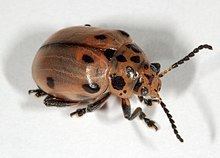Rank Genus | Order Coleoptera | |
 | ||
Similar Galerucinae, Commiphora africana, Atelopus chiriquiensis, Sphaeroderma | ||
Diamphidia or Bushman arrow-poison beetle, is an African genus of leaf beetle. Diamphidia in the Chrysomelidae family, the same family as the Colorado potato beetle.
Contents
The larvae and pupae of Diamphidia produce a toxin used by Bushmen as an arrow poison. The Finnish explorer Hendrik Jacob Wikar, who travelled in Southern Africa in 1773–1779, described the larvae as "poisonous worms". Hans Schinz was the first scientist to document the process by which the Bushmen extract and use the poison.
The adults and larvae of Diamphidia nigroornata feed on Commiphora angolensis (Engler), whereas Diamphidia vittatipennis eat African myrrh.
Life cycle
Adult females of Diamphidia femoralis Gerstaecker and Diamphidia nigroornata (Stål) lay their eggs on the stems of Commiphora species and coat the eggs with their faeces which hardens into a protective covering. As the larval instars develop, the pellets of their own faeces remain attached to their backs and posteriors. The final instar sheds this faecal coat when entering the soil to pupate. The same behaviour is found in Blepharida, a Flea Beetle and Polyclada, the African Leaf Beetle. The Diamphidia larvae burrow down for a depth of up to 1 metre in the sand under the food plant, where they may lie dormant for several years before going through a very rapid pupal phase.
Toxin
Diamphotoxin, the poisonous compound in Diamphidia, is highly labile, and has a low molecular weight. It is bound to a protein that protects it from deactivation. It causes an increased permeability of cell membranes, which, while not affecting normal ionic flow between cells, allows easy access to all small ions, thereby fatally disrupting normal cellular ionic levels. Although it has no neurotoxic effect, it produces a lethal haemolytic effect, and may reduce haemoglobin levels by as much as 75%, leading to haemoglobinuria.
Parasite host
Diamphidia is parasitised by a carabid Lebistina beetle, the larva of which attaches itself to a mature Diamphidia larva, clinging to it until the Diamphidia has formed its cocoon, enclosing both host and parasite, and then feeding on its host's soft tissue. The Lebistina larvae are more toxic than their hosts and are preferred by San hunters for arrow poison.
